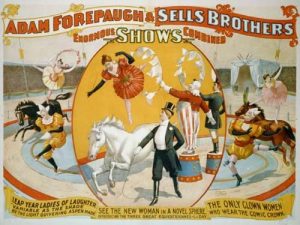Nowadays, various kind of posters can be seen anywhere, from indoor promo graphics to large-sized billboard. Originally served as a method of governmental public notification, America’s poster from the past were so different from what we know in contemporary time.
The earliest type of “artistic” posters in America were those used by travelling circuses to tell the people of their upcoming performance. A circus agent would come ahead to each town or village, spreading them around a few days before arrival of the circus. Those in the 1850s were made from wood veneer by hand drill and router, in the way of panto graph, usually portrayed the circus crow in bright colors with exaggerated wording. These posters worked extremely well to attract customers, but often ridiculed by critics of the same period.

From the 1880s onward, when lithographic became available for commercial use, poster from this method bloomed all over Europe, even boosted itself into the level of fine arts. The trend quickly catched up in America after a few years, with big contributions from Edward Penfield and William Bradley, whose style blended features of the British Arts and Crafts Movement, the Japanese block printing and the popular Art Nouveau. As the poster was produced by drawing with greasy color crayons onto a fine “mold” surface, the offsetting it to the paper, this method open opportunity for more beautiful typing detailed graphic.

On the other hand, traditional posters with pure-text contents continued to grow with the help of typographic. Designed to be viewed from distance, broadsides-as their name at that time- had a few different type sizes, and type styles from one single piece. Headlines or key details would have bigger typing and looked more attractive.


Lecture summary: During this period, there are many interesting event happens. The lecture introduced us to the beginning of the great exhibition and its effect on people, the origin of Morris, Marshall, Faulkner and co, art and craft movement, poster ( specifically the French’s poster), part of the photography evolution and the father of the Eiffel towel . World fair opened people eyes to the future with technology and culture around the world. The art and craft movement developed in short amount of time with a significant improvement in creating exquisite items. I am especially interested with illustrated poster and I can see it had came a long way comparing to the previous poster. Artist still indicate lots of detains but they organized it to please the audience eyes.More over, they also tried to be more creative with typography which make poster looks way more interesting.
